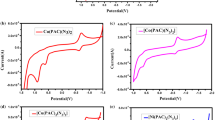Summary
Stability constants of Cu(II) and Zn(II) complexes with nucleosides have been determined from a computer analysis of potentiometric titration results. Spectral investigations prove that in acidic solution adenosine coordinates to Cu(II)via its N1 or N7 atoms, while atpH>7 only N7 is involved. Similar interactions are observed for dAdo complexes. Spectral and potentiometric studies suggest that Zn does not form stable complexes with dAdo. In the case of cytidine and deoxycytidine, the preferred site of coordination is the N3 atom of the nucleoside. Oxygen atoms from the carbonyl groups are not involved in Cu(II) or Zn(II) coordination. The results of the spectral investigation have excluded the ribose and deoxyribose moieties of all studied ligands from participation in the interactions. In general, the mode of coordination of nucleosides and deoxynucleosides with Cu(II) and Zn(II) has been found analogous.
Zusammenfassung
Mittels einer Computeranalyse von Ergebnissen aus potentiometrischen Titrationen wurden Stabilitätskonstanten für Komplexe aus Cu(II) bzw. Zn(II) und Nucleosiden bestimmt. Spektroskopische Untersuchungen zeigen, daß Adenosin in saurer Lösung über N1 oder N7 an Cu(II) koordinieren kann, während beipH>7 nur N7 reagiert. Analoges wird für die Komplexe mit dAdo beobachtet. Aus spektroskopischen und potentiometrischen Untersuchungen geht hervor, daß Zn mit dAdo keine stabilen Komplexe bildet. Im Fall von Cytidin und Deoxycytidin ist N3 die bevorzugte Koordinationsstelle des Nucleosids. Die Sauerstoffatome der Carbonylgruppen sind an der Bindung an Cu(II) und Zn(II) nicht beteiligt. Die spektroskopischen Ergebnisse schließen eine Beteiligung der Ribose- und Deoxyriboseeinheiten an den Wechselwirkungen aus. Allgemein wurde für Nucleoside und Deoxynucleoside ein analoger Koordinationsmodus gefunden.
Similar content being viewed by others
References
Martin R. B. (1986) Metal ions binding to nucleosides and nucleotides. In: Xavier A. V. (ed.) Frontiers in bioinorganic chemistry. VCH Press, Weinheim
Marzilli L. G. (1981) Metal ions in genetic information transfer. Eichorn G. L., Marzilli L. G. (eds) Elsevier/North-Holland, N. Y., Amsterdam, Oxford, p. 47
Casassas E., Izguierdo-Ridorsa A., Tauler R. (1990) J. Inorg. Biochem.39: 327
Kopf-Maier P., Kopf H. (1987) Chem. Rev.87: 1137
Sherman S. E., Lippard S. J. (1987) Chem. Rev.87: 1153
Tewari K. C., Lee J., Li N. C. (1970) Trans Farad. Soc.66: 2069
Martin R. B. (1985) Acc. Chem. Res.18: 32
De Castro B., Pereira J., Gameiro P., Lima J. L. F. C. (1992) J. Inorg. Biochem.45: 53
Kozelka J., Chottard J.-C. (1990) Biophys Chem.35: 165
Fichtinger-Schepman A. M. J., Van Oesterom A. I., Lohman P. M., Berens F. (1987) Cancer Res.47: 3000
Eastman A. (1986) Biochemistry25: 3912
Marzilli I. G., Kistenmacher Th., Eichhorn G. L. (1980) Nucleic acid-metal ion interaction. Spiro T. G. (ed.) Wiley, New York
Sigel H. (1980) Coordination Chemistry — 20. D. Benerjea D. (ed.) Pergamon Press, Oxford, New York
Kinjo Y., Tribolet R., Corfu N. A., Sigel H. (1989) Inorg. Chem.28: 1480
Scheller K. H., Scheller-Krattiger V., Martin R. B. (1981) J. Am. Chem. Soc.103: 6933
Kim S. H., Martin R. B. (1984) Inorg. Chim. Acta91: 19
Tauler R., Cid J. F., Casassas E. J. (1990) Inorg. Biochem.39: 277
Sigel H. (1987) Eur. J. Biochem.165: 65
Sigel H., Massound S. S., Tribolet R. (1988) J. Am. Chem. Soc.10: 6857
(1976) The Merck Index. Windholz M. (ed.) Merck and Co., Inc. Rahway, N. J., USA
Lomozik L. (1984) Monath. Chem.115: 261
Irving M. H., Miles M. G., Pettit L. D. (1967) Anal. Chim. Acta38: 475
Harper H. A., Rodwell V. W., Mayes P. A. (1979) Review of Physiological Chemistry. Lange Medical Publications, Los Altos
Zielonacka — Lis E. (1985) Stabilnosc wiazania glikozydowego modyfikowanych nukleozydow w reakcjach hydrolizy. Doctoral thesis (in Polish), Poznan
Sayce I. G. (1968) Talanta115: 1397
Gans P., Sabatini A., Vacca A. (1985) J. Chem. Soc. Dalton Trans. 1195
Lomozik L., Jaskolsksi M., Wojciechowska A. (1991) Polish J. Chem.65: 1797
Ingri N., Kakolowicz W., Sillen L. G., Warqvist B. (1967) Talanta14: 1261
Sigel H. (1989) Biol. Trace Elem Res.21: 49
Glasoe P. K., Long F. A. (1960) J. Phys. Chem.64: 188
Sovago J., Martin P. B. (1980) Inorg. Chem.19: 2868
Sigel H., McCormick D. B. (1970) Acc. Chem. Res.3: 201
Schneider P. W., Brintzinger H., Erlenmeyer H. (1964) Helv. Chim. Acta47: 992
Fiskin A. M., Beer M. (1965) Biochemistry1: 1249
Bario J. R., Sattsanyi P. D., Gruber B. A., Dariman L. G., Leonard N. J. (1976) J. Am. Chem. Soc.98: 7408
Mutai K., Gruber B. A., Leonard N. J. (1976) J. Am. Chem. Soc.98: 4095
Remin M., Shugar D. (1973) J. Am. Chem. Soc.95: 8136
Jones A. J., Grant D. M., Winkley M. M., Robins R. K. (1970) J. Am. Chem. Soc. 92: 4079
Espersen W. G., Hutton W. C., Chow S. T., Martin R. B. (1974) J. Am. Chem. Soc.96: 8111
Espersen W. G., Martin R. B. (1976) J. Am. Chem. Soc.98: 40
Beatie J. K., Fensom D. J., Freeman H. C. (1976) J. Am. Chem. Soc.98: 900
Gasowska A., Lomozik L., unpublished data
Marzilli G., Castro B., Caradonna J. P., Stewart R. C., Van Vuuren C. P. (1980) J. Am. Chem. Soc.102: 916
Mathlouthi M., Seuvre A. M., Koenig J. (1983) Carbohydr. Res.122: 31
Mathlouthi M., Seuvre A. M., Koenig J. (1986) Carbohydr. Res.146: 1
Lettellier R., Ghomi M., Taillandier E. (1986) J. Biomol. Struct. Dynam.3: 671
Martin R. B. (1961) Fed. Proc.20 [Suppl. 10]: 54
Kinjo Y., Ji L., Corfu N. C., Sigel H. (1992) Inorg. Chem. 31: 5588
Author information
Authors and Affiliations
Rights and permissions
About this article
Cite this article
Gasowska, A., Lomozik, L. Mode of coordination and stability of Cu(II) and Zn(II) complexes with adenosine, deoxyadenosine, cytidine and deoxycytidine. Monatsh Chem 126, 13–22 (1995). https://doi.org/10.1007/BF00811753
Received:
Accepted:
Issue Date:
DOI: https://doi.org/10.1007/BF00811753




